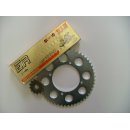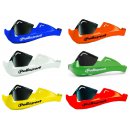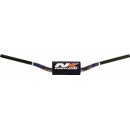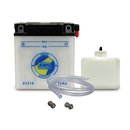Funktionsweise:

Please take a few moments to review the following
instructions. You'll notice that the MP sag scale has been designed for
simplicity, and takes away the guess work or math required tha's common with
other brands. Motion Pro has made every effort to ensure that you get full use
of the tool and have a basic knowledge of proper sag settings. However, these
are only guidelines and it is recommended that you refer to your motorcycle's
service manual for specifications and adjustments to your suspension components
on your particular model.
Setting Rider Sag
- Starting with the rear of the bike, place the motorcycle on a stand that
allows the suspension to fully extend. Unfold your Motion Pro sag scale and
thread the knob into the guide pin and set it at a point in the slotted area,
so that when the guide pin is placed in the rear axle hole the 0 (zero) on the
scale will be close to the reference point you will use to take your
measurements (see image 1.)
- Place the guide pin of the sag scale in the rear axle hole. Move the guide
pin in the slot to zero the sag scale to a point on the chassis. The seat
bolt, fender bolt, or a mark from a felt pen or section of tape (see image 2)
on the fender make good reference points. Note: Be sure to use the same
reference point with each measurement taken.
- Take the bike off of the stand (see image 3), and measure with the bike
under its own weight. Check your service manual for sag specifications but
your measurement should fall approximately between 25 and 35mm. This is static
sag. If adjust- ments are required to achieve this measurement please refer to
your service manual for specifications and instructions on adjusting your
spring preload.
- With someone holding the bike steady and the rider aboard in a normal
seating position and their full weight distributed (feet on the pegs), have
the rider bounce up and down on the suspension several times then allow it to
settle to a resting position. Using your reference mark you should now see a
reading somewhere in the area of 90 to 100mm (see image 4). This is your rider
sag. If rider sag is less than 90mm with the correct static sag, your spring
is probably too stiff for your riding weight. If rider sag is more than 100mm
with the correct static sag, your spring is probably too soft for your riding
weight. Corrections should be made, such as replacing your spring. Please
refer to your service manual for recommended spring rates and
servicing.
 Fork Sag Procedures
Fork Sag Procedures
- Place the bike back on a stand that allows the suspension to fully extend.
Place the guide pin in or as close to the center of the front axle as
possible. Using the 0 (zero) mark as your starting point, place a small piece
of tape just below the triple clamp to use as your reference point. (see image
5)
- With the bike off the stand measure the front suspension sag with no rider
aboard. With the front brake locked, depress the front suspension several
times then allow it to return to a resting point (see image 6). The static sag
should be 5 to 10% of the total travel (Example: 300mm travel = 15 to
30mm).
- Using the same reference point as used for the static sag, and with the
rider aboard in a normal seating position with their feet on the pegs, lock
the front brake and depress the forks several times, then allow them to return
to a settled position. Check the measurement (see image 7), it should be
between 25 and 30% of the total fork travel. (Reference your service manual
for specifications on fork travel for your motorcycle.) If your bike has 300mm
of fork travel it should have 75 to 90mm of rider sag. If this measurement is
in excess of 90mm, and the static sag is in the correct range of 15 to 30mm, a
stiffer set of fork springs would be advised. If the measurement is less than
75mm, a softer set of springs would be recom- mended. Remember, your bike?s
measurements may vary from these examples. Always refer to your service manual
for complete details on your specific model; the information here is given as
a guideline only.










